1. Which one of the following is an example of a monoecious plant?
A. Maize
B. Pawpaw
C. Pineapple
D. Bean
2. The importance of phototropism in plants is to enable
A. plants grow towards mineral salts and water
B. climbing plants get grip on their support
C. plants in shade grow faster and get exposed to light
D. plant root gain anchorage
3. Figure 2 shows the variation of body temperature of an animal with environment temperature.
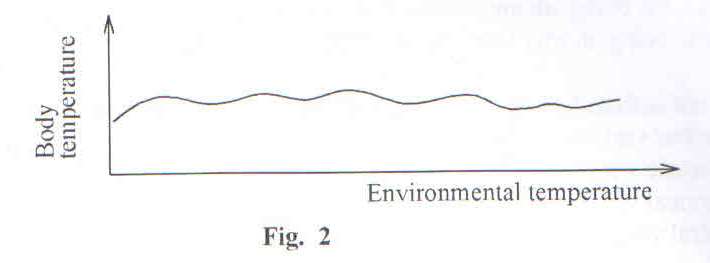
Which one of the following animals would have its temperature varying as shown in the figure?
A. Snake
B. Bird
C. Toad
D. Snail
4. A mother of twins has blood group A. One of the sons has blood group AB while the other has blood group O. Which one of the following is the blood group of the father?
A. Group A
B. Group B
C. Group O
D. Group AB
5. Which one of the following animals has a different type of fertilization from the rest?
A. Chicken
B. Lizard
C. Crocodile
D. Frog
6. Which one of the following graphs in figure 3 correctly represents the variation of the rate of transpiration with humidity?

7. When Benedict’s reagent was added to a solution containing a food nutrient and the mixture boiled, a yellow precipitate was formed. This shows that
A. non reducing sugar was absent
B. reducing sugar was present
C. non reducing sugar was present
D. traces of reducing sugar were present
8. A soil example was heated at 1000C to a constant weight. Which component of the soil was being investigated?
A. Organic matter
B. Air
C. Microorganisms
D. Water
9. Which one of the following sets consists of only dry indehiscent fruits?
A. Achne, cypsela, nut
B. Cryopsis, legume, capsule
C. Achne, follicle, legume
D. Schizocarp, capsule, caryopsis
10. A seedling was illuminated from one side and after 3 days it bent towards the direction of light because
A. auxins concentrated on the side away from light and caused faster growth on that side
B. light accelerated growth of seedlings causing bending
C. auxins concentrated on the side towards light and caused less growth on that side
D. light generally promotes elongation of plant tips causing them to bend
11. In which one of the following associations do both organisms benefit?
A. Round worm in human gut
B. Fungi and algae living together
C. Liver fluke in liver of sheep
D. Plasmodium in human blood
12. Which stage of mitosis is represented in figure 1?

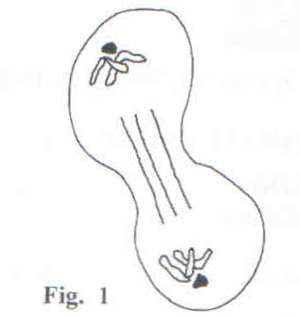
A. Prophase
B. Metaphase
C. Anaphase
D. Telophase
13. A soil with poor water retention ability has
A. low capillary
B. small particles
C. poor aeration
D. poor drainage
14. Which one of the following is a method of controlling tapeworms?
A. Use of insecticide
B. Chlorination of water
C. Draining of stagnant water
D. Proper of disposal of sewage.
15. Which of the following occur during expiration in humans? The diaphragm
A. flattens and intercostals muscles contract
B. flattens and intercostals muscles relax
C. becomes dome shaped and intercoastal muscles contract
D. becomes dome shaped and intercostals muscles relax
16. Which one of the following factors favors cross pollination?
A. Stamens and carpels maturing at the same time
B. Flowers remaining closed after maturation
C. Stamens being situated below the stigma
D. Style being shorter than the filament.
17. A vertebra with a short neural spine and long transverse processes is a
A. lumbar vertebra
B. thoracic vertebra
C. cervical vertebra
D. sacral vertebra
18. Which of the following hormones are both produced by gonads?
A. Testosterone and adrenaline
B. Follicle stimulating hormone and thyroxin
C. Progesterone and oestrogen
D. Anti-diuretic hormone and oestrogen
19. Which of the following are products of aerobic and anaerobic respiration?
A. Water and carbon dioxide
B. Carbon dioxide and energy
C. Ethanol and water
D. Carbon dioxide and lactic acid
20. Which one of the following is an adaptation of external parasites?
A. Loss of sense organs
B. Possession of rudimentary digestive system
C. Poorly developed reproductive system
D. Presence of claws
21. Which one of the following happens when the osmotic pressure of blood is higher than normal?
A. Less ADH is secreted and more water is reabsorbed
B. Less ADH is secreted and less water is reabsorbed
C. More ADH is secreted and more water is reabsorbed
D. More ADH is secreted and less water is reabsorbed
22. Which one of the following structures of a bony fish enables it to vary its density while swimming?
A. Lateral fin
B. Dorsal fin
C. Pectoral fin
D. Swim bladder
23. Which one of the following is a result of increased levels of adrenaline in the body?
A. Increased uptake of glucose by the liver
B. Decrease in rate of breathing
C. Reduction in metabolic rate
D. Increased rate of heart beat
24. Double fertilization occursin plants when
A. two egg nuclei are fertilized by a male nucleus
B. one male nucleus fuses with the egg nucleus and another fuses with the polar nuclei
C. one male nucleus fuses with the polar nuclei
D. two male nuclei fuse with two egg nuclei
25. Hairy leaves with sunken stomata is typical of plants living in soils which
A. face shortage of water
B. have a high concentration of salts
C. are well supplied with water
D. grow in shaded areas
26. In plants, tallness is dominant to shortness. When two heterozygous parents from F2 generation were crossed, 2508 offspring were produced. What was the approximate number of tall plants among the offspring?
A. 627
B. 836
C. 1254
D. 1881
27. Which one of the following is a tactic response?
A. Bending of plant shoot towards light.
B. Growth of a root towards water
C. Withdrawal of a blowfly larva from light
D. Rolling up of leaves on being on being touched
28. Which one of the following is a vector for yellow fever?
A. Aedes mosquito
B. Culex mosquito
C. Anopheles mosquito
D. Black fly
29. Figure 4 represents part of the nitrogen cycle
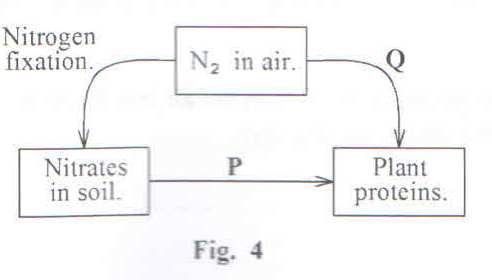
The processes a P and Q are __________ respectively
A. decaying and nitrification
B. absorption and nitrogen fixation
C. decomposition and denitrification
D. death and putrefaction
30. Which type of roots are found on a rhizome?
A. Adventitious roots
B. Fibrous roots
C. Tap roots
D. Lateral roots
31. Figure 5 shows the amount of carbon dioxide in the air in a forest over a period of 24 hours measured during a sunny day.
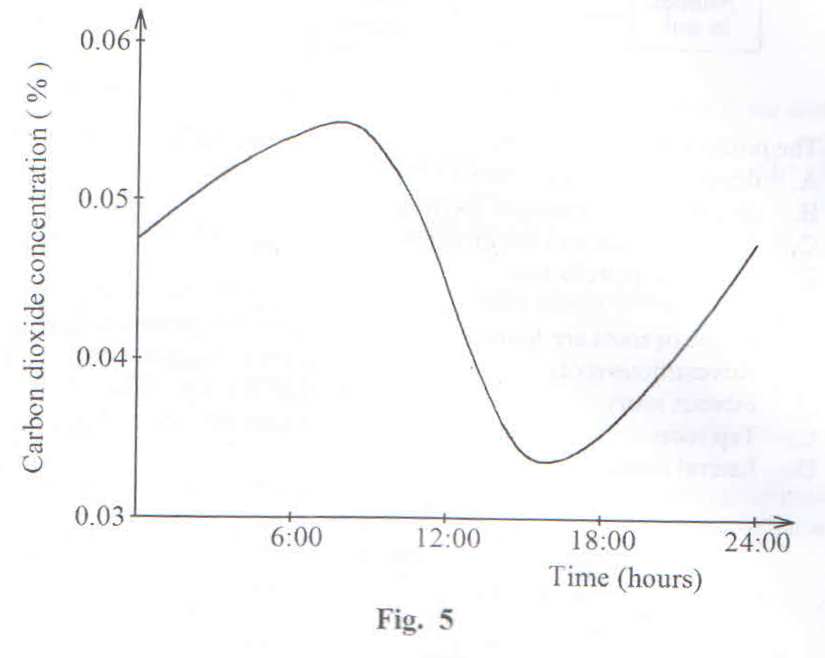
a) Explain the changes in carbon dioxide concentration
i) between 08:00 hours and 16:00 hours
ii) between 16:00 hours and 24:00 hours
b) i) At what time was carbon dioxide highest?
ii) Why?
c) i) At what time was carbon dioxide lowest?
ii) Why?
d) i) On the same graph in Figure 5, draw a sketch to show the variation in the concentration of carbon dioxide over the same period of time if the measurement was carried out during a cloudy day.
ii) Explain the variation in carbon dioxide concentration in your sketch compared to the original graph.
32. In an ecosystem, eagles feed on chickens, lizards, termites, caterpillars and grasshoppers. Caterpillars, termites and grasshoppers feed on green plants.
a) What is an ecosystem?
b) i) Construct a food chain to show the feeding relationship between termites, eagle, green plants and chickens.
ii) Which organisms in the food chain receives the least energy in the food chain in b(i). Explain your answer.
c) Construct a diagram to show the feeding relationship between all the organisms in the ecosystem above.
d) Name the trophic level to which each of the following organisms belong.
i) Chickens
ii) Termites
iii) Green plants
iv) Eagles
33. Figure 6 is a diagram showing part of the mammalian circulatory system.
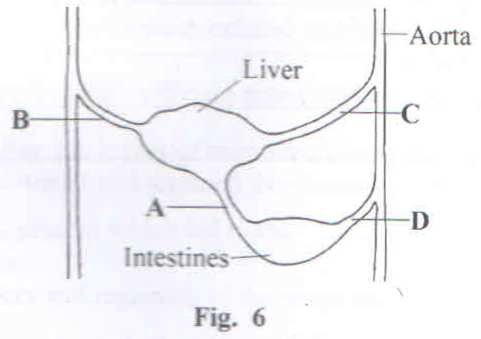
a) Name the blood vessels labeled A,B,C and D
b) Using arrows, show on the diagram the direction of blood flow in the blood vessels labeled A and B.
c) State three differences in composition of blood flowing in A and B.
d) Explain the changes in the composition of glucose in A and B.
e) How is blood vessel A structurally adapted to perform its function?
SECTION C
Answer any two questions
34. a) Distinguish between a homozygous and heterozygous state in genetics.
b) When a tall pea plant was crossed with a short pea plant, only tall pea plants were produced in F1 generation. When two plants from the F1 generation were crossed, the resulting F2 generation had a mixture of all and short pea plants.
i) Using suitable symbols, show genetic crosses to produce F1 and F2 generations
ii) If the F2 generation had 81 plants determine how many would be short and tall.
c) Giving a reason state the phenotype which is recessive in pea plants.
35. a) What is the importance of gaseous exchange in animals?
b) Describe the process of exhalation in humans.
c) Outline differences between exhaled and inhaled air in humans.
d) Explain how lungs are efficient respiratory surfaces.
36. On a hot sunny day, the leaves of bean seedlings were seen wilted. However at night, they recovered and regained their normal shape and size.
a) Explain the process which led to the
i) wilting
ii) recovery and regaining of the shape and size.
b) Explain the ecological advantage of wilting to a plant.
37. a) Describe what happens in an animal cell during each of the following stages of mitosis:
i) Prophase
ii) Anaphase
b) State the importance of mitosis.
c) Give three differences between mitosis and meiosis
